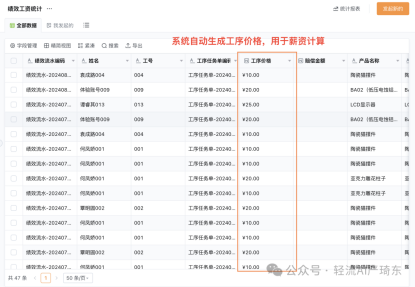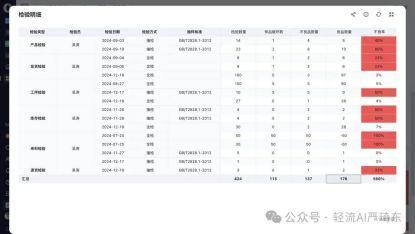# AI + Supply Chain Collaboration! Effortlessly Build an Efficient Supply Chain System on the Wingent Platform
A. What is Supply Chain Collaboration?
Supply chain collaboration refers to the coordinated efforts of node enterprises within the supply chain to enhance the overall competitiveness of the supply chain. It emphasizes that through information sharing and business process synchronization among enterprises, optimal resource allocation and efficient utilization can be achieved, thereby meeting customer needs and improving the responsiveness and flexibility of the supply chain.
In today's enterprise production management, supply chain collaboration offers multiple benefits. Firstly, it can effectively reduce costs. By sharing information on inventory levels, production capacity, and demand forecasts, companies can avoid over - production or under - stocking, which directly cuts down on inventory costs and production waste. Secondly, it boosts efficiency. When all nodes in the supply chain operate in sync, the flow of goods and information becomes smoother, reducing lead times and improving overall productivity. Thirdly, it strengthens the cooperative relationships among enterprises. As they work closely together towards common goals, trust and understanding are built, which is crucial for long - term business success.
Many well - known companies have implemented supply chain collaboration strategies. For example, Walmart has established a highly collaborative supply chain system. It shares sales data with its suppliers in real - time, enabling suppliers to adjust their production and inventory levels accordingly. This way, Walmart can maintain low inventory levels while ensuring product availability on the shelves. Another example is Apple. Apple works closely with its suppliers in terms of product design, production planning, and quality control. By collaborating with a global network of suppliers, Apple can ensure the high - quality and timely production of its products, which is a key factor in its market success. Learn more about supply chain collaboration at Investopedia - Supply Chain Management.
B. How Does AI Relate to Supply Chain Collaboration?
AI has revolutionized the way supply chain collaboration operates. With the development of AI technology, it has become an indispensable part of modern supply chain management.
Predictive Analytics
AI - powered predictive analytics can analyze vast amounts of historical data, including sales data, market trends, and supply chain disruptions. By using machine learning algorithms, it can accurately forecast future demand. For instance, if a company is in the fashion industry, AI can analyze past sales patterns, social media trends, and even weather forecasts to predict which styles and sizes of clothing will be in high demand in the coming seasons. This allows suppliers to plan their production in advance, reducing the risk of over - production or stock - outs.
Smart Inventory Management
AI can optimize inventory levels in real - time. It can continuously monitor inventory levels at different nodes in the supply chain and automatically reorder products when stock levels reach a certain threshold. Moreover, AI can take into account factors such as lead times, shipping costs, and supplier reliability to determine the most cost - effective reorder quantity and time. For example, a manufacturing company can use AI to manage its raw material inventory. The system can predict when a particular raw material is likely to run out based on production schedules and consumption rates, and then place an order with the most suitable supplier.
Supply Chain Visibility
AI enhances supply chain visibility by integrating data from various sources, such as IoT devices, transportation systems, and warehouse management systems. This provides real - time information on the location and status of goods throughout the supply chain. For example, in a logistics network, AI can track the movement of trucks, ships, and airplanes in real - time. If there is a delay due to traffic, bad weather, or mechanical problems, the system can quickly notify all relevant parties and suggest alternative routes or solutions. This improves the responsiveness of the supply chain and reduces the impact of disruptions.
Risk Management
AI can identify potential risks in the supply chain, such as supplier bankruptcy, natural disasters, or geopolitical issues. By analyzing historical data and current events, AI can assign risk scores to different suppliers and supply chain routes. This enables companies to develop contingency plans in advance. For example, if a supplier in a particular region is at high risk of being affected by a natural disaster, the company can source from an alternative supplier or increase its inventory levels of critical components.
Process Automation
AI can automate many routine tasks in the supply chain, such as order processing, invoicing, and quality control. For example, using natural language processing (NLP), AI can read and process purchase orders and invoices, reducing the time and effort required for manual data entry. In quality control, computer vision technology can be used to inspect products on the production line, quickly identifying defects and ensuring product quality.

Overall, AI has the potential to transform supply chain collaboration. It can make the supply chain more efficient, flexible, and resilient, helping companies to better adapt to the dynamic market environment and gain a competitive advantage.
C. How Does Wingent Facilitate Supply Chain Collaboration?
Wingent is a powerful platform that offers comprehensive solutions for supply chain collaboration. It combines the latest technologies, including AI, to help companies build and manage efficient supply chain systems.
1. Order - to - Production Synchronization
When a sales order is confirmed on the Wingent platform, the system automatically generates a production plan. This plan takes into account factors such as production capacity, inventory levels, and order priorities. At the same time, it triggers the material pre - occupation process. Warehouse staff can then use barcode scanners to pick materials for production. After production is completed, a quality inspection is carried out, and qualified finished products are stored in the warehouse. This seamless process ensures the smooth execution of the production plan.

2. Cross - Departmental Collaboration
Wingent promotes cross - departmental collaboration by providing a unified management platform. It allows different departments, such as sales, procurement, production, and warehousing, to share information and resources. For example, the technology department can prepare detailed process documents and accurate BOM (Bill of Materials) lists in advance. Through regular production coordination meetings and task - sharing features on the platform, departments can break down information silos and work together towards the common goal of achieving the production plan.

3. Inventory Management
Wingent helps companies optimize their inventory management. It allows for the real - time sharing of inventory data among different departments. The procurement department can use this data to make informed purchasing decisions, while the sales department can adjust their sales strategies based on inventory levels. By setting appropriate inventory levels and strict material acceptance, usage, and inventory - checking processes, companies can avoid material shortages or over - stocking, reducing inventory costs.

4. Quality Control
The platform also offers a comprehensive quality control solution. It covers the entire process of raw material inspection, in - process inspection, and finished product inspection. Through digital process design, inspection tasks can be automatically assigned, results can be entered and reviewed, improving the efficiency and accuracy of quality control.

5. Performance Evaluation
Wingent establishes a scientific performance evaluation system. It uses key indicators such as production efficiency, inventory turnover rate, and on - time delivery rate to regularly evaluate different aspects of supply chain management. Based on the evaluation results, the platform provides targeted improvement suggestions and measures. This helps companies continuously optimize their supply chain processes, improve management levels, and enhance overall competitiveness.
By using the Wingent platform, companies can achieve significant improvements in their supply chain collaboration. For example, some companies have reported a 20% - 30% reduction in inventory costs, a 15% - 25% increase in production efficiency, and a 10% - 20% improvement in on - time delivery rates.
In conclusion, supply chain collaboration is essential for modern enterprises to thrive in a competitive market. AI has brought new opportunities and capabilities to supply chain collaboration, enabling more efficient and intelligent operations. The Wingent platform, with its powerful features and user - friendly interface, provides an ideal solution for companies to implement supply chain collaboration strategies. Whether it is optimizing inventory management, enhancing cross - departmental collaboration, or improving quality control, Wingent can help companies build a more efficient and resilient supply chain system, ultimately leading to increased profitability and market share.
Reference:
[1] 1小时,我用轻流搭建了一套生产进销存系统 https://mp.weixin.qq.com/s/EnvzmggTgM9cSDqZtVSJ3Q
[2] 生产计划、排产调度、现场管控、质量管理怎么做?一文看懂生产全流程管理 https://mp.weixin.qq.com/s/DR2qqMLPuA4ADOOJvtuLPw
[3] 5000字详解生产质量管理:供应链、工序、检验、溯源、工具、激励、文化 https://mp.weixin.qq.com/s/TSQHoUsDtlWldBNkiUFbIw
常见问题
Question
- Answer
What is supply chain collaboration?
- It's coordinated efforts of node enterprises to enhance supply - chain competitiveness.
What benefits does supply chain collaboration offer?
- It reduces costs, boosts efficiency, and strengthens enterprise relationships.
Can you give an example of a company using supply - chain collaboration?
- Walmart shares sales data with suppliers to adjust production and inventory.
How does AI relate to predictive analytics in supply - chain collaboration?
- AI analyzes historical data to accurately forecast future demand.
What role does AI play in smart inventory management?
- AI optimizes inventory in real - time, considering multiple factors.
How does Wingent facilitate cross - departmental collaboration?
- It provides a unified platform for departments to share info and resources.
What is the function of Wingent's performance evaluation system?
- It uses key indicators to evaluate and give improvement suggestions.
How has AI transformed supply - chain collaboration overall?
- AI makes the supply chain more efficient, flexible, and resilient.